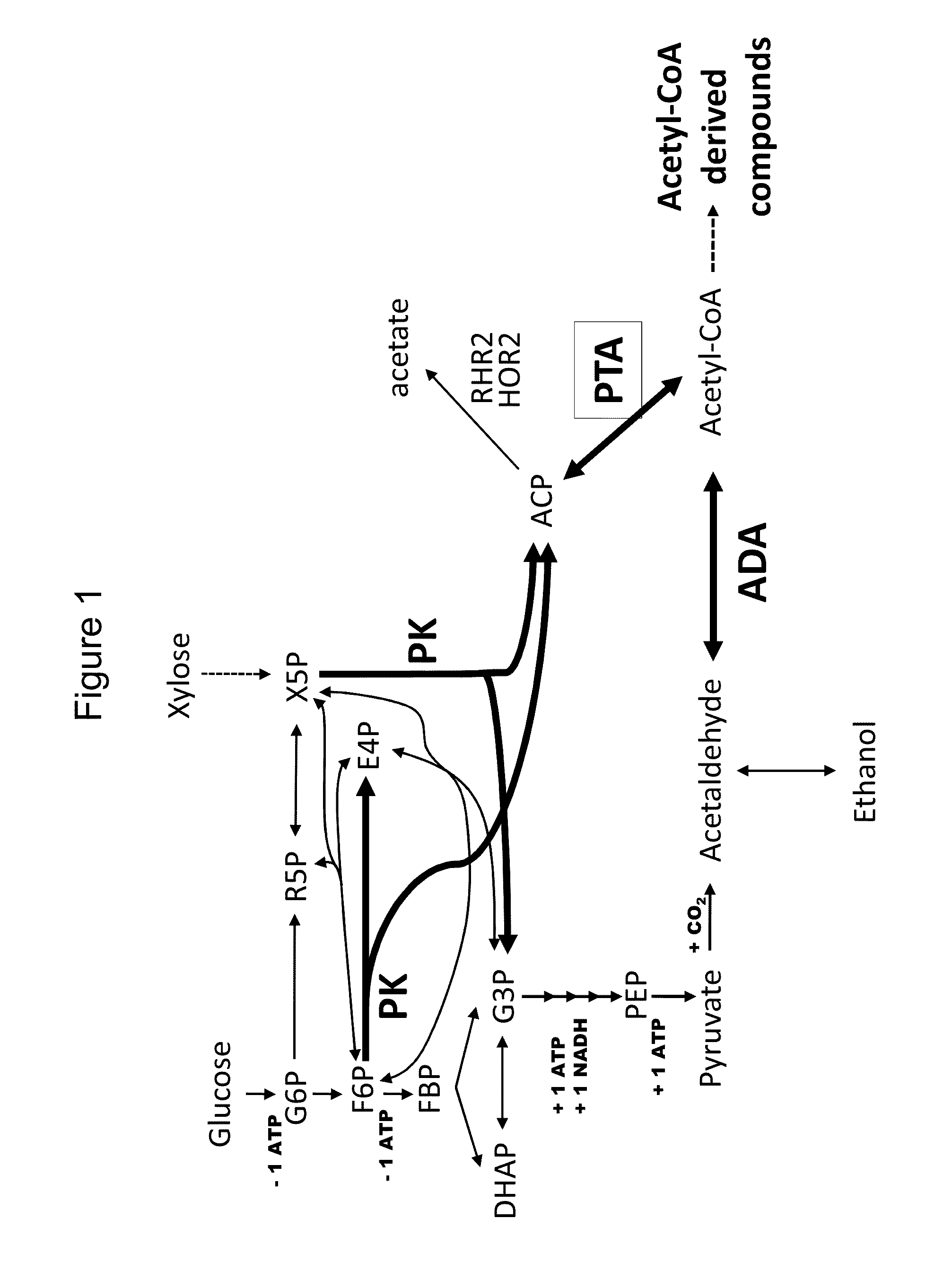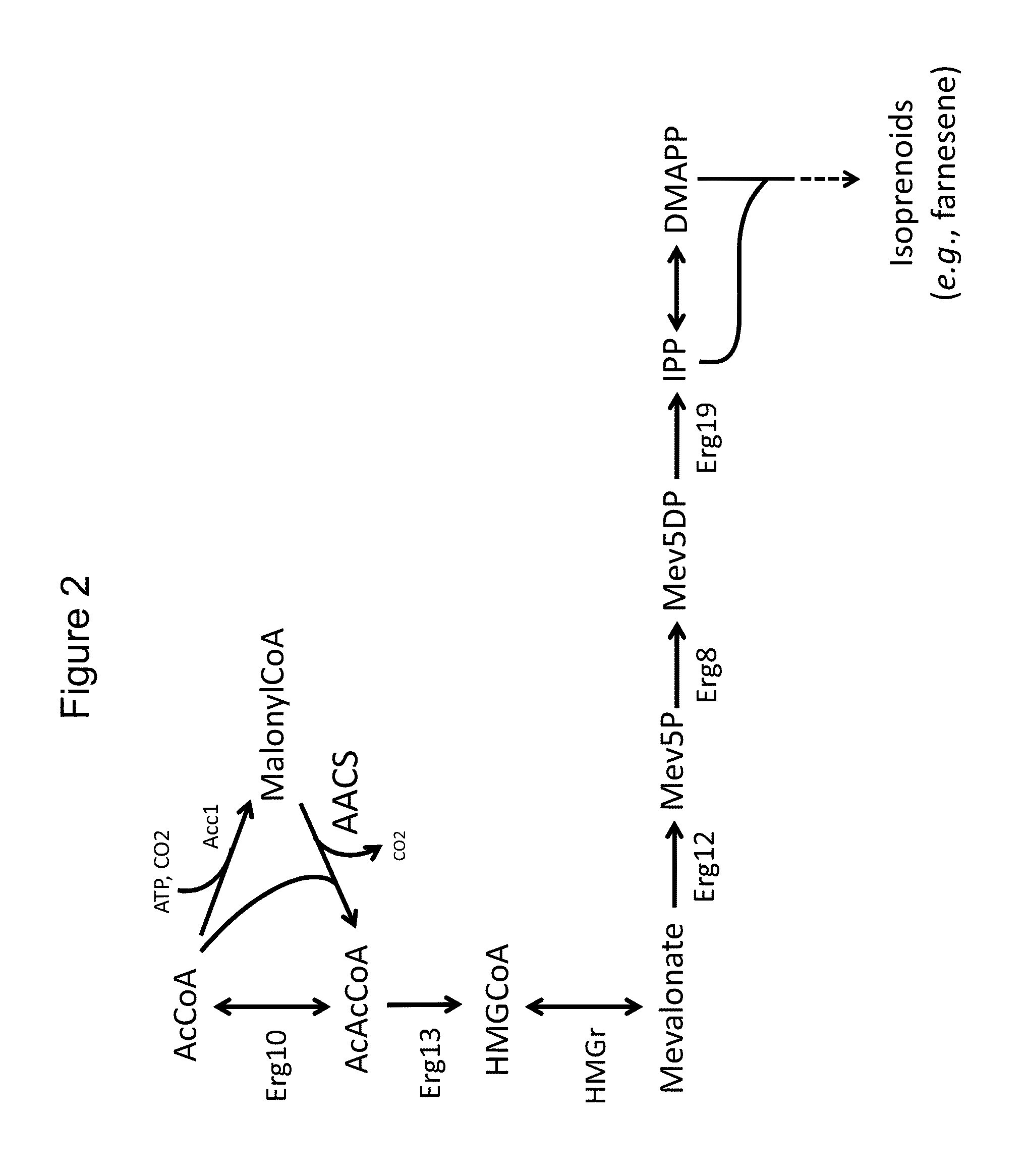Use of phosphoketolase and phosphotransacetylase for production of acetyl-coenzyme a derived compounds
a technology of phosphoketolase and phosphotransacetylase, which is applied in the field of composition and method, can solve the problems of negatively affecting production and hydrolysis of acetyl phosphate, and achieve the effects of reducing acetate accumulation, carbon flux, and improving utilization of phosphoketolas
- Summary
- Abstract
- Description
- Claims
- Application Information
AI Technical Summary
Benefits of technology
Problems solved by technology
Method used
Image
Examples
example 1
6.1 Example 1
Acetate Production in Host Cells Expressing PK and PTA
[0261]This example describes the production of acetate in yeast strains heterologously expressing phosphoketolase and phosphotransacetylase.
[0262]6.1.1 Materials and Methods
[0263]6.1.1.1 Strain Engineering
[0264]6.1.1.1.1 Y967 and Y968
[0265]Y967 and Y968 are wildtype prototrophic Saccharomyces cerevisiae CEN.PK2, Y967 is MatA, and Y968 is Matalpha. The starting strain for Y12869, Y12746, and all of their derivatives, was Saccharomyces cerevisiae strain Y003 (CEN.PK2, Mat alpha, ura3-52, trp1-289, leu2-3,122, his3̂1). All DNA-mediated transformation into S. cerevisiae was conducted using the standard lithium acetate procedure as described by Gietz R W and Woods R A, Guide to Yeast Genetics and Molecular and Cell Biology. Part B. San Diego, Calif.: Academic Press Inc. pp. 87-96 (2002), and in all cases integration of the constructs were confirmed by PCR amplification of genomic DNA.
[0266]6.1.1.1.2 Y12869
[0267]Y12869 was...
example 2
6.2 Example 2
Identification of a Major Acetyl Phosphatase in Saccharomyces cerevisiae
[0297]This example describes the identification of an enzyme capable of hydrolyzing acetyl phosphate in yeast.
[0298]6.2.1 Materials and Methods
[0299]6.2.1.1 Cell Culture
[0300]A single colony of a given yeast strain was cultured in 5 mL Yeast Extract Peptone media with 2% dextrose (YPD) as an overnight starter culture. The following day, 50 ml YPD was inoculated with this starter culture to an OD600 of 0.2. The flasks were incubated at 30° C. by shaking at 200 RPM for 24 hours unless otherwise specified.
6.2.1.2 Cell-Free Extract Preparation
[0301]Cell culture was divided into three 15 mL falcon tubes and harvested by centrifugation at 4000×g for 5 minutes. The supernatant was then discarded and cells were washed by resuspending in 10 mL ice cold buffer W (100 mM Tris-HCl pH 8.0, 150 mM NaCl, 10% glycerol) followed by centrifugation at 4000×g for 5 minutes. Supernatant was discarded and cells were res...
example 3
6.3 Example 3
Deletion of the Acetyl Phosphate Phosphatase Reduces Acetate Secretion and Improves Production of a Compound Derived from Acetyl-CoA
[0325]6.3.1 Materials and Methods
[0326]6.3.1.1 Strain construction
[0327]Versions of Y968, Y12869, and Y12746, lacking a functional URA3 gene, were transformed with either ms63907 or ms63909, and with ms64472, to convert them to farnesene producers.
[0328]The ms63907 integration construct (i84022; SEQ ID NO:33) is shown below.
HO USGAL4pGAL10ERG10URA3PGAL1Sp.HMGrHO DS
This construct comprises nucleotide sequences that encode a selectable marker (URA3); a copy of the native yeast GAL4 transcription factor under its own promoter; two native yeast enzymes of the mevalonate pathway (ERG10 which encodes Acetoacetyl-CoA thiolase, and ERG13, which encodes HMG-CoA synthase), as well as two copies of a yeast codon-optimized version of Silicibacter pomeroyi HMG-CoA reductase, all under galactose-inducible promoters (promoters of the S. cerevisiae genes G...
PUM
 Login to View More
Login to View More Abstract
Description
Claims
Application Information
 Login to View More
Login to View More - R&D
- Intellectual Property
- Life Sciences
- Materials
- Tech Scout
- Unparalleled Data Quality
- Higher Quality Content
- 60% Fewer Hallucinations
Browse by: Latest US Patents, China's latest patents, Technical Efficacy Thesaurus, Application Domain, Technology Topic, Popular Technical Reports.
© 2025 PatSnap. All rights reserved.Legal|Privacy policy|Modern Slavery Act Transparency Statement|Sitemap|About US| Contact US: help@patsnap.com



